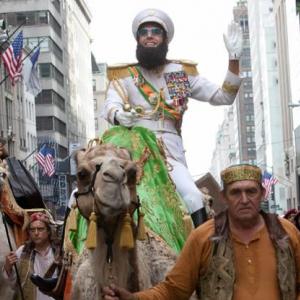
Gareth Higgins (garethhiggins.net) is a writer and broadcaster from Belfast, Northern Ireland, who has worked as an academic and activist. He is the author of Cinematic States: America in 50 Movies and How Movies Helped Save My Soul: Finding Spiritual Fingerprints in Culturally Significant Films. He blogs at www.godisnotelsewhere.wordpress.com and co-presents “The Film Talk” podcast with Jett Loe at www.thefilmtalk.com. He is also a Sojourners contributing editor. Originally from Northern Ireland, he lives in Asheville, North Carolina.
Posts By This Author
Beauty as Antidote
THE EXPERIMENTAL psychologist Steven Pinker writes that what we think we have seen will shape what we expect to occur. It doesn’t make the news when people die peacefully in their sleep, or make love, or go for a walk in the countryside, but these things happen far more often—are much more the substance of life—than the acts of terror that preoccupy the media. It was horrifying when a British soldier was killed on an English street in May. But given the ensuing ethnic tension and communal judgment, it might have been useful, not merely accurate, to report that on the same day, almost 3 million British Muslims didn’t kill anyone. Because violence is a pre-emptive act (I kill you because you might kill me), when we keep telling the story that the threat of massive violence is ever-present, we will behave more violently.
According to Richard Rohr, the best criticism of the bad is the practice of the better. So perhaps attention to beauty is the best alternative to our cultural obsession with blood. For me, cinema can do this better than any other art form, and is uniquely capable of transporting the imagination. Recently I’ve traveled to the minds of retired Israeli security service leaders agonizing over their achievements and failures in The Gatekeepers, gone to Louisiana for a trip around the soul of a man trying to redeem himself in Mud, empathized with the tragic story of a man making bad choices to get into a better state in The Place Beyond the Pines, wondered at the creative process and bathed in the French countryside in Renoir, been reminded of and elevated into an imagining of love and its challenges in To the Wonder, and been provoked in Room 237 to consider whether or not Stanley Kubrick intended The Shining to be a lament for the genocide that built America.
Transcending a Genocidal God
HOW IS IT that a miniseries based on the Good Book could evoke sectarian and violent notions of the Divine that would have seemed backward to some even back in the era of melodramatic biblical epic cinema? The History channel’s The Bible, like so much of so-called “religious pop culture,” seemed to be the product of good people trying to do a good thing, but at best putting the desire to convey a particular message ahead of making the best artwork for the medium.
The politics of The Bible seemed to perpetuate an “us vs. them” lens. It left me wishing for a treatment of scripture presented from the perspective of the marginalized, instead of a portrayal of “victory” as being the deaths of people considered different. Couldn’t someone make an Exodus movie about Moses’ neighbors—you know, the ones who saw God’s favor rest on the boy next door, while their son was killed by a psychopathic king? Or one focused on the myriad people groups considered “unclean” and worthy of genocide at the hands of those who claim to speak for God? Or a rendering of John’s Revelation that understands it as a poem about remarkable beginnings, the battles of the human heart, and a love willing to remake the world to set us free from the traps we’ve laid for ourselves? You don’t even have to be that controversial—can’t someone just make a decent movie about Ruth or any of the many cool women in the gospels?
Paved with Good Intentions
I’VE WINCED often at the portrayal of religion in recent documentaries—partly out of embarrassed identification with some of the apparently crazy things I’ve witnessed in real life, and partly because some documentarians seem to think that there’s nothing to religion other than those crazy things. God Loves Uganda, a new documentary about the role played by U.S. missionaries in nurturing that country’s homophobic culture and legislation, manages to avoid the mistake of confusing bad religion with all religion.
The concern for the Ugandan people manifested by fundamentalist charismatic Christians is suggested to be far less than the sum of its parts as they become participants in the nurturing of a social structure that aims to eradicate gay people. But the film avoids easy stereotyping of Christian mission work, particularly in the person of Bishop Christopher Senyonjo, a smiling radical in the mold of Desmond Tutu. His is a face of Ugandan Christianity that is open, generous, alive, courageous, and kind—a prophetic African voice for human rights.
Wendell Berry recently suggested that the expression of anti-LGBTQ sentiment may evoke a kind of subconscious reaction in the proponent akin to autoerotic pleasure. Delighting in the pain of others is a kind of sadism rooted in the insecurities harbored by the person who has decided it’s their job to be the moral police, despite how kind they may think they are being. The fear stirred by psuedo-Dominionist movements may have given the U.S. missionaries in God Loves Uganda a sincere desire to change the world. But their lack of self-reflection leads them to export some of the worst of American cultural imperialism: prejudice, the conflation of sentimentality and cultural ignorance with love, the denial of the gift that the other has for us.
A True Contender
PAYING ATTENTION isn't easy in a world of infinite content, but there's a reason artists and prophets from Jeremiah to Arthur Miller have called upon us to sit up and listen: A drop of water or a focused breath may be as inexhaustible as a symphony or a thousand-mile trek. And one film? It could contain the world. On the Waterfront is not that film (for me it's Andrei Tarkovsky's transcendent portrait of a 15th century icon painter, Andrei Rublev), but it belongs in the canon all right. The new Criterion BluRay edition not only offers the crispest representation of the 1954 New Jersey dockyard visuals any of us have ever seen, it also illustrates the sociopolitical and creative context in a manner richer than any previously released.
So the story of a former prize fighter torn between his brother's mob ties, a blossoming love affair, his broken ambition, and desire to do the right thing emerges once again, six decades after first exploding onto the national consciousness, winning eight Oscars along the way. It's six decades and a bit more since its director, Elia Kazan, testified before the House Un-American Activities Committee, another man making a tough decision amid nearly impossible pressure: name names and survive or take the Fifth and receive exile. It's one decade after a perhaps more self-conscious Academy gave Kazan a lifetime achievement Oscar, though half of the audience chose to sit on their hands. We may ask whether or not the grace of God would have enabled any of us to do differently than Kazan, or if he perhaps had good reason to challenge the worst Soviet practices in the 1940s, or if the value of an artwork depends on the integrity of the artist. More questions besides are explored in the array of features on this On the Waterfront disc—interviews with Kazan, a documentary about the film's making, and a transcript of Kazan's defense of his testimony.
Time to Start Talking
THE CEO OF one of the world's most popular video-game manufacturers recently denied any relationship between his products (some of which have their users re-enact mass slaughter) and real killing. The substance of such denial appeared to some to be no more complex than "because I said so, and some other people agree with me." Meanwhile, in the immediate aftermath of the Aurora movie theater shootings last year, Hollywood producer Harvey Weinstein called for a summit of directors to discuss their imaginary guns. He later acknowledged that "I don't have the answers to these questions. ... They're so complicated; you need people with better facts and intelligence. In this situation I have to be a follower, not a leader." Refreshing humility from someone better known for bluster and self-assurance, now opening a door to a conversation on which lives may depend.
Film critics, too, have a responsibility to contribute to this conversation, so let me propose some ideas:
1. Portrayal and advocacy are not the same thing. The violence of Reservoir Dogs and Looper may be visceral, but it tells the truth about the suffering that guns and knives can inflict and may help people think twice about enacting real violence. The violence ofHome Alone andTransformers may be cartoonish, but it lies to the audience and may fuel appetites for further destruction.
2. The shape of the narrative arc may be more influential than any particular acts of violence. Our culture seems to be addicted to the idea that order can be brought out of chaos by ultimate force, that violence can literally "cleanse the world." This myth—this religion—shows up everywhere, not just in the movies. Indeed, it is a keystone of our politics. The best thing movies can do about it is to tell a different story.
Oscars and the Big Picture
WE SHOULDN'T really expect the Oscars to grasp the point of history, though this year the films nominated for Best Picture are a fascinating snapshot of what ails—and could heal—us.
Zero Dark Thirty takes a clinical view of the search for Bin Laden and has been criticized for its portrayal of torture as effective. To my mind this debate may miss the wider question: Torture is bad enough, but a central assumption about the efficacy and validity of killing for peace—that shooting an old man in his bedroom would solve anything—is worthy of enhanced interrogation.
The point is missed also in the brouhaha about Django Unchained, Quentin Tarantino's thrilling satirical Western. People are up in arms about the comic book violence and use of the N-word—but this is perhaps the most powerful, even indelible, portrayal of the violence of slavery ever made for a mainstream audience. Two wrongs don't make a right, and the revenge arc in this film should be questioned, but Tarantino has done a moral service in not sanitizing his fictionalization of historical memory. Lincoln is the perfect companion piece—I highly recommend you see both. Django Unchained uses B-movie tropes to vastly entertain while confronting the real horrors Abraham Lincoln was fighting to end. Lincoln is a theatrical history lesson that delicately handles the moral authority competitions, language games, and political complexity behind the 13th Amendment.
Top 10 of 2012
THE BEST experiences I had at the cinema last year were nostalgic—re-releases of The Life and Death of Colonel Blimp and Lawrence of Arabia were uncanny reflections on the cost of war to soldiers and some roots of contemporary Middle East strife. Here's my list of the best films released in 2012:
10. A tie:The Pirates! Band of Misfits, a gloriously rich, smart comedy for all ages, full of life and self-deprecating humor, and Life of Pi, which envelopes its audience with visual wonders and spiritual questions.
9. Wes Anderson's delightful treatment of childhood first love amid dysfunctional adults, and a film not afraid of the shadow side of growing up, Moonrise Kingdom.
8. The Cabin in the Woods, a gruesome horror comedy that not only enacts and portrays, but understands the lie of redemptive violence.
Assassins and Psychopaths
THREE OF THE best films of the year arrived in early fall and will hopefully still be around to experience by the time you read this. Each deserves to be seen on a big screen—I've long believed that the experience of watching films in a cinema compares with home viewing the same way that visiting the pyramids compares with seeing a mummy in a museum. But whether or not you see these in a cinema, please do see them.
Samsara, Looper, and Seven Psychopaths open up worlds of possibility where the varieties of human experience are respected, the myth of the cool assassin is revised, and the morality of violent fiction is stared in the face, interrogated, and not let go without an attempt at a convincing answer.
Samsara, the sequel to 1992's Baraka, travels the world seeking examples of our diversity and unity: dancers and warriors and builders and menders, broken things and healed things, innocent and wounded. It contains some of the most extraordinary imagery you've ever seen, in tune with vast musical cultures, reimagining our view of what we, a little lower than the angels, are and can be, and, when we're not conscious of our power, the damage we can do.
Battles for Self
THE MASTER, Paul Thomas Anderson’s stomach-punching, fingernails-down-a-chalkboard psychological thriller loosely based on the founding of Scientology, might be more deeply understood as a tale of two egos. We witness a titanic battle for self-control by a man who knows nothing of it (Joaquin Phoenix’s Freddie Quell), while another struggles to distinguish imagination from delusion, his simmering rage emanating perhaps from the terror that the truth he has found may not be enough (Philip Seymour Hoffman’s L. Ron Hubbard surrogate, Lancaster Dodd). Neither of them knows how to love; both are desperate to be loved. They find in each other a conversation partner, a patient, an unrequited lover. They are two of the most human characters the movies have brought us in a long time; their power trips are terrifying, because they may remind us of our own.
There are many key moments: The first meeting between the war veteran and new religious leader, the dictator bonding with his subject over mutual substance abuse; the master holding court in New York society, first offering tender words of potential healing to a grand dame, then exploding at a guest who dares question the source of his “knowledge”; the protégé being experimented with, commanded to walk up and down between a wall and a window until he is both capable of imagining unbridled freedom and driven nearly mad in the process; a science-fictionesque digging for buried treasure on Arizona flatlands that could pass for Mars.
The moment that remains most resonant in my memory after two viewings is still the most ambiguous to me. After Freddie and Dodd first meet, the new father invites the new son (the relationship—and failings of relationship—between fathers and sons is where this film really aches) to attend his daughter’s wedding. The invitation is accompanied by a warning or an invocation: Dodd tells him either “Your memories aren’t welcome” or “Your memories are welcome.” Two viewings leave it unclear—I could check a third time, but it doesn’t really matter, for each is a blessing. You don’t have to carry your trauma always and everywhere. Or you can join this community and still be fully yourself.
Becoming Who We Are
RECENT MOVIES have been dominated by a surprising theme: the exploration of gender through black goo in outer space, strippers in Florida, and a red-haired teenage rebel in mythical Scotland. Detours among British ex-pats in India in The Best Exotic Marigold Hotel, a genetically modified high school student in New York in The Amazing Spider-Man, and a scout troop on a coastal New England island in the fabulous Moonrise Kingdom added flavor to the mix. But it was the deceptively simplest of films that caused me to think most about what it means to be a human being, and how the fact of gender must be wrestled with, negotiated, and contested rather than assumed.
The wonderful thing about Pixar’s Brave is how it negates the historic disempowerment of female fairy tale protagonists. This is a new kind of Disney princess: one who doesn’t need a man to save her, nor homicidal violence to achieve victory; one who develops a healthy relationship with her mother; one, ultimately, who takes responsibility for her mistakes, integrating Snow White purity with Mulan’s steel. It’s also a physically beautiful movie, delightfully entertaining, and alive for adults and kids alike.
On the other hand, the world of Magic Mike, wherein Channing Tatum relives his earlier career as a bachelorette-party treat, is a film about lost men who play on stereotypical female desire for tips. The soulful yearning for intimate connection that Mike embodies is the most emotionally resonant part of a film otherwise of average interest.
Satire and Political Shadows
IN THE 1930s, the Marx Brothers took political satire seriously enough to make a comedy about imperialism. Duck Soup stands today as one of the most comforting movie antidotes to the depressing post-9/11, enemy-until-proven-friend political culture. The 1960s saw Stanley Kubrick upgrade the cinematic presentation of war into Dr. Strangelove: Or How I Learned to Stop Worrying and Love the Bomb—employing the Screwtapian dictum that if the devil cannot bear to be mocked, then the best way to reveal the horror of war is to laugh at it. A decade later, Mel Brooks attacked—and transcended—white supremacy in Blazing Saddles, a film whose coruscating offensiveness is merely a mirror to our own prejudices. Sacha Baron Cohen is the evident successor to the Marxes, Kubrick the comic satirist, and Brooks. (Some of Michael Moore’s work, and both Armando Iannucci’s In the Loop and Chris Morris’ Four Lions, deserve attention in this light too.)
Baron Cohen’s trilogy of fish-out-of-water-in-the-U.S.A. films, Borat, Bruno, and current release The Dictator, taken together, constitute both deliriously funny entertainment (sometimes confused, and with something to offend truly everyone) and a jeremiad against the monstrosities of our time: racism, sexual violence, homophobia, xenophobia—and that’s just for starters. The Dictator has post-9/11 politics, the war on terror, Islamophobia, and anti-Semitism clearly in its sights. Our hero—for that is what he ultimately becomes—is a Middle Eastern tyrant in the Saddam/Gadhafi mold, with a bit of Ahmadinejad and even Kim Jong-Il thrown in for good measure. He gets lost in New York and experiences what life is like outside the palace, leaving behind its personal executioner and other amenities. His path to liberation and respecting others comes through working in a vegan grocery store—not an unrealistic program in the non-cinematic world. What’s remarkable about his transformation is that it comes in response to meeting a broader variety of characters than you’d find at the U.N., and to being mentored in treating sexuality (his own and others’) with more respect.
Screening Relevance
THE TRUTHS flickered into visible expression at the Full Frame Documentary Film Festival are, minute-for-minute, usually among the cinematic highlights of the year.
The line between documentary and fiction movies has blurred: On the one hand, even a Hollywood package as huge as The Dark Knight has its share of verite-style intimate handheld camerawork (and thoughtful politics—Batman is presented as nothing less than the necessary sacrifice for a community that has to kill someone to stay “pure”). On the other, the top 10 grossing documentaries of all time were each released in the past decade: Audiences are attracted by the fusion of social engagement and entertainment like never before.
Michael Moore’s appearance at the festival reminded me how common it is for activists to want to make films just because it’s cool (which usually makes for bad films), or for filmmakers to inject a dose of socially “relevant” messaging into their movie because they think it will increase the box office. (Think of when churches jumped on the bandwagon for Mel Gibson’s The Passion of the Christ. Mel got rich. Jesus, I aver, stayed 99 percent poor.) Moore’s point is that you should make documentaries because you want to make films—you can be an activist without being a filmmaker.
But if you’ve got the heart and the talent, it should rise to the surface, and if it does, you’ll usually end up at Full Frame, where this year’s highlights were three films that mingle mature cinematic craft with ethical depth.
Art With a Brutal Heart
DISNEY ANIMATION is often criticized for masking cynical corporate values—Wall-E’s profound challenge to over-consumption was accompanied by the selling of toys and games; the company claims to be pro-feminist but only tweaks the fairytale princess archetype with heroines who express their “strength” by showing that they can fight like a man.
Yet there’s still some magic in the Disneymagination—Fantasia, The Jungle Book, and The Lion King, despite their political alarm bells (racism and homophobia are challenged and reinforced, the average of which can only compute to ambivalence), are examples of visual resplendence, a sense of humor, and an invitation to hope. The best parts of the Disney worldview look like the eschatological images in a Martin Luther King Jr. speech; the worst merely bolster a culture of privilege and exclusion.
The most Disney-like current film is Mirror, Mirror, a retelling of the Snow White story, directed by the fantastic visual stylist Tarsem Singh. It features Julia Roberts in a wickedly entertaining turn as the queen, with a witty script, gorgeous set and costume design, and some bawdy fun. But the portrayal of Snow White as a “liberated” young woman whose liberation depends on her behaving like a Bruce Willis action character produces a paradox: Any of the images from this film could be exhibited in an art gallery—so elegantly composed and imaginative are they—but the ethical heart of the film isn’t artful at all.
A Sci-Fi Take on Adolescence's Brutal Truth
Along with the silent film The Artist, Haywire, and War Horse, the smartest wide-release recent movie is Chronicle, a kinetic fusion of Breakfast Club-style teenage angst with post-9/11 violence-as-a-way-of-life (or at least way-to-be-noticed).
In St. Patrick's Footsteps: Humor and Humanity
Fifteen-hundred years ago, a Dublin-based shepherd made his mark on history by turning the Chicago River green, staggering inebriated through the city, and inventing the "Kiss Me I’m Irish" hat. Along the way, he wrote Bushmills whiskey drinking songs about the pain of being alive, mixed a cocktail whose name evokes an act of terror, and dyed his hair red.
He magically expelled snakes from the island of his birth, wrote a lyrical memoir of his terrible childhood, won the Rose of Tralee beauty contest, mixed lager and Guinness together (presumably out of an excess of self-loathing and bad taste), had a great oul’ Famine, stared meaningfully across the Atlantic, and dreamed of America.
But he still hasn’t found what he’s looking for.
It’s St Patrick’s Day weekend, and despite the fact that millions of people will celebrate something like this vision of what it means to be Irish, pretty much none of the above is true.
10 For Home Viewing
A perfect time to catch up on the 10 best Blu-ray releases of the past year.
Hope Three Ways
Hugo, Take Shelter, and The Mill and the Cross have little in common on the surface other than their quality; look deeper and you may find love-filled, theologically profound, hopeful invitations to live better.
Power and No Glory
Roland Emmerich is known for making the kind of disaster movies that fans of quality filmmaking love to hate.
A Few Good Men
Clooney's new movie, The Ides of March, serves as a thoughtful and entertaining mirror for next year's presidential election.
You Can Still Live
The round-up on late-summer cinema, including: Solaris, The Tree of Life, and Super 8.






